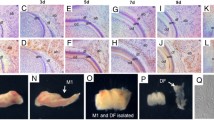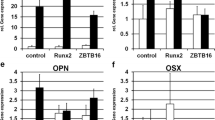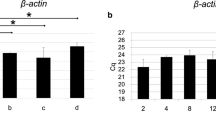Abstract
Recently, osteogenic precursor cells were isolated from human dental follicles, which differentiate into cementoblast- or osteoblast– like cells under in vitro conditions. However, mechanisms for osteogenic differentiation are not known in detail. Dental follicle cell long-term cultures supplemented with dexamethasone or with insulin resulted in mineralized nodules, whereas no mineralization or alkaline phosphatase activity was detected in the control culture without an osteogenic stimulus. A real-time reverse-transcriptase polymerase chain reaction (PCR) analysis was developed to investigate gene expression during osteogenic differentiation in vitro. Expression of the alkaline phosphatase (ALP) gene was detected during differentiation in the control culture and was similar to that in cultures with dexamethasone and insulin. DLX-3, DLX-5, runx2, and MSX-2 are differentially expressed during osteogenic differentiation in bone marrow mesenchymal stem cells. In dental follicle cells, gene expression of runx2, DLX-5, and MSX-2 was unaffected during osteogenic differentiation in vitro. Osteogenic differentiation appeared to be independent of MSX-2 expression; the same was true of runx2 and DLX-5, which were protagonists of osteogenic differentiation and osteocalcin promoter activity in bone marrow mesenchymal stem cells. Like in bone marrow-derived stem cells, DLX-3 gene expression was increased in dental follicle cells during osteogenic differentiation but similar to control cultures. However, gene expression of osterix was not detected in dental follicle cells during osteogenic differentiation; this gene is expressed during osteogenic differentiation in bone marrow stem cells. These real-time PCR results display molecular mechanisms in dental follicle precursor cells during osteogenic differentiation that are different from those in bone marrow-derived mesenchymal stem cells.


Similar content being viewed by others
References
Ten Cate AR (1997) The development of the periodontium – a largely ectomesenchymally derived unit. Periodontology 13:9–19
Wise GE, Frazier-Bowers S, D’Souza RN (2002) Cellular, molecular, and genetic determinants of tooth eruption. Crit Rev Oral Biol Med 13:323–334
Morsczeck C, Götz W, Schierholz J, Zeilhofer F, Kühn U, Moehl C, Sippel C, Hoffmann KH (2005) Isolation of precursor cells (PCs) from human dental follicle of wisdom teeth. Matrix Biol 24:155–165
El Nesr NM, Avery JK (2002) Development of the teeth: root and supporting structures. In: Avery JK, Steele PF, Avery N (eds), Oral development and histology, 3rd ed. Thieme, New York, pp 108–122
Thesleff I, Mikkola M (2002) The role of growth factors in tooth development. Int Rev Cytol 217:93–135
Morsczeck C, Moehl C, Götz W, Heredia A, Schäffer TE, Eckstein N, Sippel C, Hoffmann KH (2005) Differentiation in vitro of human dental follicle cells with dexamethasone and insulin. Cell Biol Int 29:567–575
Shirakabe K, Terasawa K, Miyama K, Shibuya H, Nishida E (2001) Regulation of the activity of the transcription factor runx2 by two homeobox proteins, MSX-2 and Dlx5. Genes Cells 6:851–856
Hassan MQ, Javed A, Morasso MI, Karlin J, Montecino M, van Wijnen AJ, Stein GS, Stein JL, Lian JB (2004) Dlx3 transcriptional regulation of osteoblast differentiation: temporal recruitment of MSX-2, DLX-3 and Dlx5 homeodomain proteins to chromatin of osteocalcin gene. Mol Cell Biol 24:9248–9261
Yoshizawa T, Takizawa F, Iizawa F, Ishibashi O, Kawashima H, Matsuda A, Endo N, Kawashima H (2004) Homeobox protein MSX-2 acts as a molecular defense mechanism for preventing, ossification in ligament fibroblasts. Moll Cell Biol 24:3460–3472
Gronthos S, Graves SE, Ohta S, Simmons PJ (1994) The STRO-1+ fraction of adult human bone marrow contains the osteogenic precursors. Blood 84:4164–4173
Frank O, Heim M, Jakob M, Barbero A, Schafer D, Bendik I, Dick W, Heberer M, Martin I (2002) Real-time quantitative RT-PCR analysis of human bone marrow stromal cells during osteogenic differentiation in vitro. J Cell Biochem 85:737–746
Young HE, Steele TA, Bray RA, Detmer K, Blake LW, Lucas PW, Black AC Jr (1999) Human pluripotent and progenitor cells display cell surface cluster differentiation markers CD10, CD13, CD56, and MHC class-I. Proc Soc Exp Biol Med 221:63–71
Yao S, Norton J, Wise GE (2004) Stability of cultured dental follicle cells. Cell Prolif 37:247–254
Peirson SN, Butler JN, Foster RG (2003) Experimental validation of novel and conventional approaches to quantitative real-time PCR data analysis. Nucleic Acids Res 31:e73
Cheng SL, Shao JS, Charlton Kachigian N, Loewy AP, Towler DA (2003) MSX-2 promotes osteogenesis and suppresses adipogenic differentiation of multipotent mesenchymal progenitors. J Biol Chem 278:45969–45977
Ichida F, Nishimura R, Hata K, Matsubara T, Ikeda F, Hisada K, Yatani H, Cao X, Komori T, Yamaguchi A, Yoneda T (2004) Reciprocal roles of MSX-2 in regulation of osteoblast and adipocyte differentiation. J Biol Chem 279:34015–34022
Willis DM, Loewy AP, Charlton-Kachigian N, Shao JS, Ornitz DM, Towler DA (2002) Regulation of osteocalcin gene expression by a novel KU antigen transcription factor complex. J Biol Chem 277:37280–37291
Nakashima K, Zhou X, Kunkel G, Zhang Z, Deng JM, Behringer RR, de Crombrugghe B (2002) The novel zinc finger-containing transcription factor osterix is required for osteoblast differentiation and bone formation. Cell 108:17–29
Kovacs KJ (1998) c-Fos as a transcription factor: a stressfull (re)view from a functional map. Neurochem Int 33:287–297
Keeton AB, Amsler MO, Venable DY, Messina JL (2002) Insulin signal transduction pathways and insulin-induced gene expression. J Biol Chem 277:48565–48573
Yamaguchi N, Chiba M, Mitani H (2002) The induction of c-fos mRNA expression by mechanical stress in human periodontal ligament cells. Arch Oral Biol 47:465–471
Gronthos S, Mankani M, Brahim J, Robey PG, Shi S (2000) Postnatal human dental pulp stem cells (DPSCs) in vitro and in vivo. Proc Natl Acad Sci USA 97:13625–13630
Acknowledgments
I thank Mr. C. Möhl and Ms. M. Römelt for technical support. My special thanks go to Prof. K.-H. Hoffmann for his support and for all the fruitful discussions.
Author information
Authors and Affiliations
Corresponding author
Rights and permissions
About this article
Cite this article
Morsczeck, C. Gene Expression of runx2, Osterix, c-fos, DLX-3, DLX-5, and MSX-2 in Dental Follicle Cells during Osteogenic Differentiation In Vitro. Calcif Tissue Int 78, 98–102 (2006). https://doi.org/10.1007/s00223-005-0146-0
Received:
Accepted:
Published:
Issue Date:
DOI: https://doi.org/10.1007/s00223-005-0146-0




